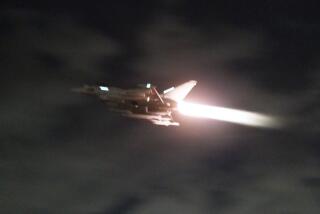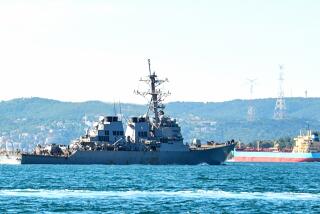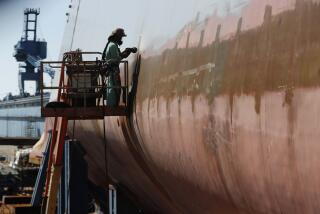U.S. Limits in Detecting Mines Cited : Special Copters May Be Sent to Aid in Gulf Area
KUWAIT â The commanding officer of one of the American warships assigned to protect Kuwaiti shipping in the Persian Gulf said Saturday that the Navy contingentâs mine-detection capability is inadequate.
âOur capability to spot a moored mine is very poor,â Cmdr. Daniel J. Murphy Jr., skipper of the destroyer Kidd, said a day after a U.S.-escorted Kuwaiti supertanker was damaged by a mine explosion.
In Washington, U.S. officials said the Reagan Administration may send Navy minesweeping helicopters to the Persian Gulf and ask Saudi Arabia for more mine-detection help in the wake of the incident.
4 Saudi Minesweepers
American diplomats have already sounded out Saudi officials on the Arab kingdomâs willingness to send its four-ship minesweeping force into the center of the gulf to sweep for mines, according to the officials, who asked not to be identified.
Murphy, interviewed by reporters aboard his ship, said: âThe U.S. Navy, like all navies, is designed for deployment of integrated forces. We have capability in detecting mines, both from helicopters and from minesweepers, but we donât have any of those things here.â
Asked why, he answered, âI donât know.â
Capt. David P. Yonkers, the officer in charge of the three-ship flotilla, agreed that the Navy lacks the resources to properly search out mines in the Persian Gulf.
Hardest to Counter
âOne of the things I do not have the capability to do is defend against mines,â he said, according to American news pool reports distributed by the Defense Department. âThe mine is far and away the most difficult to defend against. Iâm very thankful now that we managed to get out safely.â
On Friday, the Kuwaiti supertanker Bridgeton, newly registered as an American oil carrier, struck an underwater mine, tethered to the seabed and presumably laid by Iran, while heading for Kuwait to load oil for the return voyage out of the gulf. The 401,382-ton tanker and the much smaller gas carrier Gas Prince, the first two of 11 Kuwaiti vessels being âreflaggedâ under American registry, were being escorted by the Kidd and two other U.S. warships when the explosion occurred in what appeared to be a freshly seeded minefield in the upper gulf.
On Saturday, divers inspected damage to the Bridgeton, anchored 4 1/2 miles off Kuwaitâs main oil port of Al Ahmadi, and found a small hole in the bottom and damage to four tanks, according to diplomatic and shipping sources.
The three-warship flotilla, also including the cruiser Fox and the frigate Crommelin, were reportedly regrouping off Bahrain on Saturday to take on supplies and reassess strategy following the incident.
The three ships sailed early Saturday morning from just outside Kuwaiti waters, where they had anchored overnight after completing the convoy that began just outside the entrance to the Persian Gulf.
In Washington, a Pentagon official, asked why the Navyâs gulf force appeared so vulnerable to mines, said only, âThatâs a good question.â
The Navy currently has only three active-duty minesweepers, and all three were in Charleston, S.C., last week, a Navy spokesman, Cmdr. John Alexander, said. In addition, the Navy also has 18 inactive minesweepers.
The Navy also has 23 RH-23D Sea Stallion helicopters outfitted for anti-mine warfare, but none of the helicopters was in the gulf either, Alexander said. In recent years, minesweeping tactics have shifted toward greater use of helicopters, which are faster and more versatile than ships and boats.
A Pentagon official who spoke on condition of anonymity said it appears likely that the Administration would decide to send one or more Sea Stallions to the gulf, if only because a minesweeping ship would need at least two weeks to reach the area.
The helicopters would need facilities in Kuwait, Bahrain or Saudi Arabia to operate effectively, he noted. In the past, those countries have provided limited facilities to U.S. forces but have tried to maintain a low profile while doing so.
President Reagan directed Secretary of Defense Caspar W. Weinberger on Friday to develop new plans for defending the convoys against mines, officials said. But a White House official said no decision is expected until Weinberger and Reagan receive a full report on the type of mine that damaged the Bridgeton and the options available to counter the threat.
Minesweeping ships and helicopters both search for mines with sonar, then detonate or disable the mines with cables or more sophisticated acoustic or magnetic devices.
The U.S. warships in the gulf also carry sonar systems, but they are designed to locate submarines, not the much smaller mines.
There are several types of mines. Some float, others are moored; some are detonated by contact with a passing ship, others by the wave of water pressure created by the ship or the magnetic influence of the vesselâs hull. Initial reports suggested that the mine that holed the Bridgeton was of the oldest, contact type.
Minesweeping ships may be the only wooden-hulled vessels left in the worldâs modern navies. The design reduces the shipâs vulnerability to magnetic mines. The Navy is currently building 14 new minesweepers, called the Avenger class, with hulls of oak and fir and superstructures of glass-reinforced plastic.
But the program, which will replace the current minesweepers dating from the 1950s, has been repeatedly delayed by budget crunches and technical setbacks. The first Avenger-class ship is not scheduled for launching until this fall.
âYou could say itâs been a pretty neglected area,â Cmdr. Alexander said.
On Saturday, the governments of Kuwait, Saudi Arabia and the United States were weighing several options for dealing with the mines sown in the gulf, which are considered Iranâs single greatest threat to shipping. The mining of gulf waters is the latest episode in the so-called tanker war, in which Iran and Iraq, at war for nearly seven years, have attacked civilian ships considered friendly to the other side.
Shipping sources quoted by Reuters news agency said that merchant ships traveling in the gulf had reported seeing rusty mines floating in the waters off Saudi Arabia, suggesting that the need for mine clearing is becoming acute.
Although it has no mine-hunting equipment in the gulf, the U.S. Navy has sent 18 mine-disposal experts to the region. The experts, working in coordination with ships and helicopters from Kuwait and Saudi Arabia, last week removed mines that had been planted in the deep-water channel leading to Kuwaitâs Al Ahmadi oil terminal.
Saudi and Kuwaiti forces have also swept and cleared harbors and shipping lanes along the southern gulf coast with U.S. help, but they have not extended their range into the central shipping lane where the Bridgeton was damaged.
After completing the escort of the Bridgeton and Gas Prince on Friday, the American ships were ordered to leave the tankers at the 12-mile boundary marking Kuwaiti waters. Reports from the ships indicated that they were given a fairly cool welcome by the Kuwaitis.
According to a pool dispatch from journalists aboard the destroyer Kidd, a Kuwaiti officer told the Americans, âYou are requested to remain outside territorial waters until further instructions from my side.â
A command broadcast over the Kiddâs public address system also said the Kuwaitis had twice called the ship requesting American helicopters to remain âclear of their airspace.â
It was unclear whether the apparent chilliness reflected a change in Kuwaiti attitudes stemming from the explosion that damaged the Bridgeton, the largest tanker in the Arab world.
Base Established
The Bridgeton hit the mine about 18 miles west of Iranâs Farsi Island, where Iranian paramilitary Revolutionary Guards have reportedly established a base to attack Kuwaiti-bound shipping.
Western diplomats said there was little doubt that Iran had laid the mine, but since there was no conclusive evidence and there were no casualties aboard the Bridgeton, retaliation by the United States was not being considered at this time, it was reported in Washington.
The damage from the mine will not prevent the Bridgeton from being filled with crude oil for a return trip down the gulf later this week. The 46,732-ton Gas Prince was already being loaded with liquefied gas Saturday.
It is expected that the Bridgeton will be repaired in drydock either in Dubai, one of the United Arab Emirates, or in Bahrain after it drops off its supply of oil at Khawr Fakkan, an Emirates port just outside the gulf.
Meanwhile, the battleship Missouri left Long Beach on Saturday for the area of the Persian Gulf, Pentagon officials said.
Defense Department spokesman Jim Turner said the Missouri had sailed âfor duty in the Pacific and Indian oceans.â He refused to say whether the giant battleshipâs mission was to help protect shipping in the gulf, but other officials said the gulf was the Missouriâs destination.
âThe Mighty Moâ
The heavily armored Missouri, known in the Navy as âThe Mighty Mo,â is one of four battleships on active duty in the U.S. fleet. The Japanese surrender that formally ended World War II was signed on its deck in 1945.
The Missouri was commissioned in 1944 and recommissioned last year after extensive refitting. It is armed with guided missiles and with 16-inch guns that fire shells the weight of a small automobile. The shipâs normal complement is 1,537 officers and men.
In a related development, the foreign ministers of six Arab nations on the Persian Gulf said Saturday that they support Kuwaitâs efforts to protect its shipping from attack.
The Gulf Cooperation Council, meeting in the Saudi Arabian resort city of Taif, also welcomed last weekâs U.N. Security Council resolution calling for a cease-fire in the Iran-Iraq conflict.
Council Issues Statement
The gulf council, a security and economic alliance representing Kuwait, Saudi Arabia, Qatar, Bahrain, the United Arab Emirates and Oman, issued a statement that avoided any direct mention of Kuwaitâs bid to protect its shipping in the gulf by re-registering 11 tankers under the U.S. flag.
The foreign ministers, whose countries are Iraqâs main source of financial assistance in the war effort, merely said they âreaffirmedâ a statement they issued June 8 that expressed support for any moves Kuwait might make.
Their meeting was overshadowed by a warning from Tehran on Friday that Iran would attack Iraqâs allies in the region if Iraq resumed air raids on Iranian oil and economic installations.
Charles P. Wallace reported from Kuwait and Doyle McManus from Washington.
More to Read
Sign up for Essential California
The most important California stories and recommendations in your inbox every morning.
You may occasionally receive promotional content from the Los Angeles Times.











